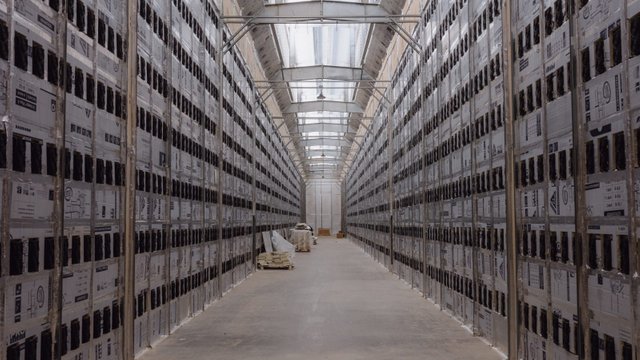On a sweltering July day, an unlikely group arrived at a shooting range in central Texas. There was Kevin Pan, CEO of the Chinese cryptocurrency mining company Poolin, and his two vice presidents, Qian Xiong and Alejandro De La Torre. It was just one stop on a sprawling, statewide tour that spanned industrial power plants, trying on sleek cowboy hats with oil prospectors, and learning how to handle AR-15 rifles.
The atmosphere was easy with their “American cowboy friends,” De La Torre told Rest of World. “Everyone here is a capitalist, and everyone wants Bitcoin to succeed,” De La Torre said. “Everyone wants to make money.”
Despite their optimism, Poolin’s executive team has been on the move, restless, for nearly three months. The Hong Kong–headquartered company is one of the world’s largest Bitcoin mining pools, groups that combine resources to mine cryptocurrency more effectively. Poolin holds the second-largest share of the global Bitcoin hashrate — a measure of the computing power it takes to mine new Bitcoin — with a network of operations across Berlin, Beijing, Chengdu, Changsha, and Singapore.
They were thrown into chaos in May, when China’s State Council banned cryptocurrency mining and trading in the country. “We were, the next day, on a flight out,” De La Torre said. “I was flying out of Germany, and my colleagues were flying out of China.” His tone was pragmatic. “Okay, I’ve got more work [to do]. That’s it.”
Up to that point, China had been a center of gravity for Bitcoin mining. Home to massive facilities that housed more than 70% of the world’s mining power, it also headquartered companies like Bitmain and Whatsminer, manufacturers of mining machines. Because Bitcoin is created by solving algorithmic “blocks” of increasing difficulty, thousands of miners harnessed their computing power in pools — the largest of which, Poolin among them, were also formed in China.
In the weeks after the ban, all scrambled to move their hardware to friendlier jurisdictions. Some crossed the border to Kazakhstan; others pitched up as far afield as Norway.
Poolin’s team went to Texas. The cowboy hats, target practice, and barbecue brisket were just a bonus. They were really there for the deregulated electrical grid.
Ousted from the provinces where they’d spent years building a footprint, China’s fleeing Bitcoin miners are now looking for stability. They want plentiful, cheap electricity to power their tens of thousands of computers — but they also want the certainty that politics won’t interfere with their operations. Before they can begin displacing the global financial system with a decentralized, peer-to-peer system of exchange, their needs are suddenly much more prosaic: predictable regulation, stable relations with governments, and affordable power.
It’s harder than it sounds. Despite the desperation of miners to find a home and the eagerness of places like Texas to house them, months after the ban, Poolin and other big Chinese miners have tested the waters in the state, but found barriers to settling.
“The crackdown was all of a sudden, and we were not prepared,” De La Torre reflected. “We don’t want instability anymore. … We are looking for something stable in the United States. The government is not going to come and close your company, like they do in China.”
A monthly meetup for Bitcoin developers at Unchained Capital in Austin, Texas in July. China’s fleeing Bitcoin miners are looking for stability in Texas.
Mining Bitcoin resembles an infinite arms race. In the early 2010s, miners were using off-the-shelf computers equipped with advanced graphics cards; by late 2013, there were roughly two dozen companies in China making specially-designed chips called ASICs. In Inner Mongolia, mining facilities were soon stacked with tens of thousands of them. And while activity flourished in a legal gray area, officials would, every so often, condemn miners for their intensive energy usage, saying it clashed with government climate change initiatives.
The early months of 2021 saw Bitcoin’s value seesaw, and as volatility became a concern to Chinese authorities, they acted quickly. On May 21, the State Council announced a ban on crypto mining and trading, to prevent, they said, “the transmission of individual risks to the social field” — a sign of their anxiety over mounting investment in ever-more speculative coins. First to shutter were massive coal-fueled operations in Xinjiang and Inner Mongolia, then the hydro-powered mining farms along rushing rivers in Yunnan and Sichuan.
But even before the ban came down, mining pools with operations abroad — Poolin among them — were on the lookout for more cheap, overseas power. In April last year, China was home to around 65% of the world’s Bitcoin mining output. By the time of the crackdown just over a year later, it was down to 46%.
Chinese miners whose computers haven’t already been padlocked by local authorities have packed them onto planes. Some, like Bitmain, have gone to Kazakhstan, whose geographic proximity, permissive regulations, and cheap coal make it attractive. But Bloomberg data suggests the country has added just 3 gigawatts of power capacity in the past two decades, leaving little room for miners to scale.
Shuyao Kong, an analyst at blockchain software company ConsenSys, said that the future of Bitcoin mining inside China is now in crisis. Some small- and medium-sized mining operations are waiting it out, said Kong, in case they can find ad hoc ways around the ban: a friendly provincial official willing to allow a few computers near a hydropower dam here, a power plant with extra floor space there.
